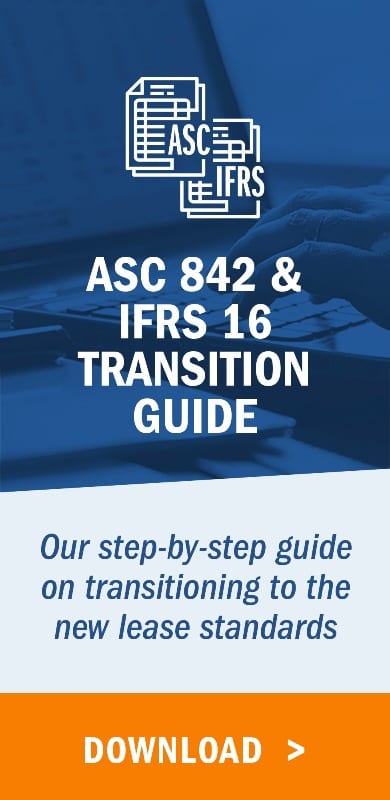Once you have compiled your lease portfolio and determined which dates are pertinent to your lease accounting, you will need to identify the payment information required to establish your initial lease liability and ROU asset. This article will assist companies with understanding how to extract the appropriate payment information from a lease agreement.
When transitioning from ASC 840 to ASC 842, the biggest change will be recognizing operating leases on the balance sheet. To accurately present the lease liability and the corresponding ROU asset, you need to calculate these amounts. Reading a lease document can be a daunting task but this article will help you identify the key information to use in the calculation.
The basic formula for calculating the lease liability is to take the present value of any remaining future lease payments. This calculation is straightforward; there is very little room for varying interpretations, judgments, or estimates. Where the lease liability calculation can be a bit trickier is in the determination of the remaining payments to capture and the discount rate to use. This article offers a comprehensive overview of the remaining payments and what should be included in the financial assessment.
Numerous payments varying in amount, timing, or triggering events can be specified within a lease agreement, and it can be hard to determine which of these to include in the lease liability calculation. ASC 842 defines the future lease payments to include in the lease liability calculation as:
- Fixed payments required by the lease agreement, such as base rent
- In-substance fixed payments required by the lease agreement
- Variable lease payments that depend on an index or rate
- Purchase options that are reasonably certain to be exercised
- Penalties for terminating the lease if the lease term reflects the lessee incurring any penalties for termination
- Fees paid by the lessee to the owners of a special purpose entity for structuring the transaction
- Payments probable of being owed by the lessee as the result of a residual value guarantee
Fixed payments
Lease payments can be separated into two categories: fixed and variable consideration.
- Fixed consideration is a payment made directly for the right to use the underlying asset and is explicitly stated in the lease contract. These payments will be included in the measurement of the lease liability and ROU asset.
- Variable consideration is a payment incurred for the right to use an asset that varies relative to changes occurring throughout the lease term. These payments are typically not included in the measurement of the lease liability or ROU asset and are simply expensed when incurred. However, variable payments may also include payments related to a stated index or rate, such as CPI. These payments are included in the lease liability calculation, and we discuss specific accounting treatment below.
An example of a fixed payment typically found in a lease agreement is base rent. Base rent is essentially the minimum required payment for a lease. It is the portion of the rent payment explicitly stated in the contract and will be a factor in evaluating the value of the asset and liability. A lease contract may include a payment schedule of the expected annual or monthly payments. Even if the contract includes escalation increments to the beginning or base payment amount, this type of rent is fixed.
Fixed vs. variable payments
When the periodic payments are structured so they cannot be calculated without the occurrence of an event, such as an amount of sales or units produced, the payments are not considered fixed. Examples of variable payments are monthly rent as a percentage of sales or a per mile rate once a mileage threshold is achieved. Variable lease costs will not be included in the lease liability calculation, but are still required to be disclosed.
Variable lease payments can be presented as what looks like a fixed payment at the beginning of a lease term, e.g. a specified amount for taxes is added to the base rent payment. However, if the payment will be reconciled to actual costs at a future date, and the lessee is required to pay the difference, the cost is considered variable because the final amount is dependent upon actual expenses. To avoid misclassifying variable payments as fixed payments, ask yourself if a reconciliation is required. If the payments are compared to actual expenses or some unknown future amount, they are likely variable.
In-substance fixed payments
In-substance fixed payments are the opposite of variable payments presented as fixed payments. These payments can be tricky because they may appear as variable payments, but are in fact, fixed. An example of in-substance fixed payments would be a lease agreement which offers a choice between two distinct payment amounts for consideration with one being variable, based on an amount of sales and the other being a required minimum amount.
While the amount based on sales is variable and cannot be calculated until sales are known, the minimum required payment is an in-substance fixed payment. The lessee knows at a minimum they will pay this amount according to the terms of the agreement and can therefore include this amount in their lease liability calculation.
Likewise for the example above of a rate for miles over a certain threshold. The lessee can calculate the lease liability with the base rent amount and any mileage overages are excluded from the initial lease measurement, to be expensed when or if incurred.
Variable payments that depend on an index or rate
As mentioned above, variable payments that depend on sales or an event are not included in the lease liability calculation. However, payments that are variable because of dependence on an index or rate are included in the initial lease liability calculation. The consumer price index (CPI) is an example of an index or rate to which a lease payment schedule may be linked.
A common use of this type of payment in a lease agreement is to specify a base rent amount with annual escalations equal to CPI. Similar to the mileage payment scenario above, the lessee knows the CPI in effect when the lease commences and can, therefore, calculate the initial lease liability with the index or rate at the lease commencement date.
The initial lease liability is calculated with the index or rate at the lease commencement date applied for the lease term. Over the term of the lease, as payments are made with the actual index or rate applied, any variance is recognized as expense. Additionally, a change in the index or rate the payments depend on does not trigger a remeasurement of the lease liability on its own. Rather, if another event occurs to cause a remeasurement, the index or rate is updated to the index or rate in effect at the remeasurement date.
Additional payments
Some payment types, such as base rent, will be the main drivers in the calculation of the lease liability, but there are other items to consider that could also have an impact on the liability balance. These items include:
- The price of a purchase option, if the lessee is reasonably certain to exercise that option,
- Penalties for terminating the lease, if the lease term used for the lease liability calculation reflects the lessee exercising an option which invokes penalties,
- Fees paid by the lessee to the owners of a special purpose entity for structuring the transaction, and
- Payments for a residual value guarantee, if the payments are probable of being owed by the lessee.
Although this is not an exhaustive list, these are the types of payments to look for within a lease agreement when calculating the lease liability. A common trait in several of this group of payments is the ability to select an option or not.
As discussed in our second article of the lease abstraction series regarding the lease term, “Determining the Correct Dates & Lease Term from a Lease Agreement under ASC 842“, calculating the lease liability can sometimes require a judgment or estimate about future events, such as:
- How far into the future to extend the lease term,
- Whether a purchase option will be exercised, or
- Whether certain penalties for fees will be incurred, such as early termination.
In these scenarios, the lessee reviews various economic factors to assess if they are reasonably certain to exercise or not to exercise an option. Reasonably certain equates with a high possibility the event will or will not occur. For an entity to be reasonably certain they will exercise or not exercise a renewal or termination option at the commencement of the lease, they have assessed the outcomes and made a decision based on the facts and circumstances of the agreement at the time.
Lease vs. non-lease components
Other payments you must consider when reading through your lease agreement are lease and non-lease components. Lease components are sections of the contract which directly transfer the right to use the underlying asset to the lessee in exchange for consideration. A non-lease component is a section of the contract which transfers a good or service to the lessee that is separate from the use of the underlying asset in exchange for consideration. Lastly, noncomponents are payments that do not contribute directly to the right to use the underlying asset and do not transfer any value to the lessee, such as property taxes or insurance.
The nature of the payment, fixed or variable, does not dictate the determination of whether it is a lease component. Frequent examples of non-lease components include the cost of common area maintenance (CAM) provided by the landlord for a real estate lease, or charges for maintenance, landscaping, janitorial, or other services related to the lease.
Some types of payments may be either a lease or non-lease component, depending on circumstances, such as a security deposit. When determining if a security deposit should be included in your lease payments, confirm if the deposit is refundable or non-refundable. In short, refundable deposits are not included as lease payments but any non-refundable deposits are, and if paid before commencement, will increase the value of the ROU asset.
It is also normal to see lease agreements structured with one payment stream consisting of both lease and non-lease components. If this is the case, ASC 842 requires the lessee to allocate the total contract consideration, or that of the combined components, to each of the individual lease and non-lease components on a relative standalone price basis. To complete the allocation lessees must find observable standalone prices for each component or estimate the standalone prices using the available market information if they are not readily available.
Lease vs. non-lease components: Practical expedient
While allocating costs between lease and non-lease components is not a new concept, lessees may not have completed this step consistently for their operating leases under ASC 840. Therefore to ease the burden of transition to ASC 842, the guidance offers a practical expedient whereby a lessee can elect to not separate combined payments into lease and non-lease components by asset class.
If the lessee chooses not to elect this practical expedient, they will need to allocate an amount of the total payment to each of the individual components and include only the lease components in their lease liability calculation. Though this allocation process may be time consuming, the result is a lower lease liability and lease asset, which may be more desirable for an entity.
If the lessee elects to exercise the practical expedient to not separate the lease and non-lease components of the total payment, the total consideration amount is used to calculate the initial lease liability. Subsequently, the lease liability and lease asset are grossed up with the non-lease components, but less resources are used to arrive at the calculation.
Discount rates
The final element that goes into your lease liability calculation will be the discount rate used to calculate the net present value (NPV). The guidance recommends using the rate implicit in the lease as the rate that best represents the intended economics of the lease. However, this rate is often not easily determined.
If the rate implicit in the lease is not easily determined, a private company can choose one of two options:
- Their incremental borrowing rate (the rate an entity would be charged to borrow a similar amount, over a similar term, on a collateralized basis), or
- A risk-free rate (i.e., treasury bills).
A private company can elect to use the IBR or risk-free rate at an underlying asset class level. When choosing a rate, consider that although the risk-free rate can be estimated more easily than the IBR or implicit rate, lower discount rates lead to higher opening liability amounts.
Summary
Once all the remaining future payments for a lease have been identified, the lease term has been determined, and the discount rate has been estimated, the final step is to calculate the initial lease liability with all of these inputs. This amount will be recorded on the balance sheet as a liability with a corresponding ROU asset and tracked in an amortization table. Use a lease accounting solution like LeaseQuery that automates the necessary amortization tables, journal entries, and disclosure reporting to allow yourself the time for more complicated tasks.
For additional resources regarding how to navigate your lease agreements and determine how the various payments will need to be accounted for when transitioning to ASC 842 check out our blogs.



